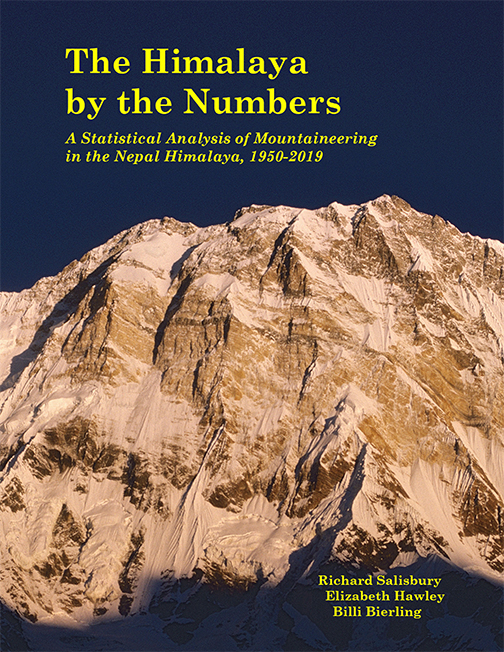 The Himalaya by the Numbers The Himalaya by the Numbers
A Statistical Analysis of Mountaineering
in the Nepal Himalaya, 1950-2019
(2nd edition)
RICHARD SALISBURY
ELIZABETH HAWLEY
BILLI BIERLING
What are the most dangerous peaks to climb? What are the safest?
When is the best time of year to climb?
These and many other questions are answered in the second edition of The Himalaya by the Numbers, a comprehensive statistical analysis of climbing activity, ascents and fatalities in the Nepal Himalaya. Expeditions from 2010 through 2019 are added to those previously covered in the first edition.
The analyses cover three periods of climbing:
1950-1969 – the expeditionary period,
1970-1989 – the transitional period and
1990-2019 – the commercial period
The data are analyzed in several categories including climbing season, expedition years (changes over time), geographical regions of Nepal, age groups, gender, citizenship, and team size and composition.
In addition, fatalities are analyzed for both members and hired personnel by causes of death with special emphasis given to avalanches, falls and physiological factors. Time of day and distance from the summit also also examined for climbing accidents. Special emphasis is given to the most popular commercial peaks, Ama Dablam, Manaslu, Cho Oyu and Everest.
250 pages with charts and tables.
Published by The Himalayan Database, Ann Arbor, Michigan (2021)
The book is freely available at the link below:
Himalaya by the Numbers, A Statistical Analysis of Mountaineering, 1950-2019 [155.7mb Pdf]
Donate to the Himalayan Database
We hope you enjoy the new version of “The Himalaya by the Numbers” which contains a myriad of information and analyses on climbing in the Nepal Himalaya. Updating it was only possible thanks to the hard work of our all-volunteer team at the Himalayan Database who spared no effort in collecting information on everyone attempting an expedition peak in Nepal. In the spirit of our founder, Elizabeth Hawley, it is important that we continue to make our knowledge-based resources available to everyone free of charge. We appreciate the generous financial donations that many of you have made in the past to support our work, which allows us to cover our operating expenses. If you value our work, and we hope you do, please feel free to use the Donate button below to help us continue onwards. Thank you so much for your support, and we look forward to seeing many of you in Spring 2022!
|

